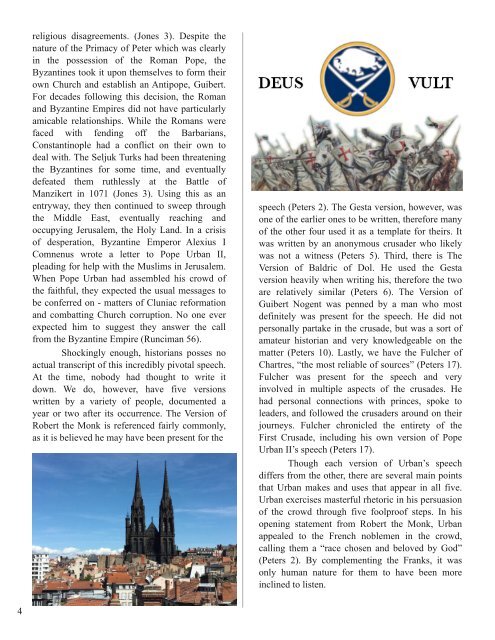Create successful ePaper yourself
Turn your PDF publications into a flip-book with our unique Google optimized e-Paper software.
eligious disagreements. (Jones 3). Despite the<br />
nature of the Primacy of Peter which was clearly<br />
in the possession of the Roman Pope, the<br />
Byzantines took it upon themselves to form their<br />
own Church and establish an Antipope, Guibert.<br />
For decades following this decision, the Roman<br />
and Byzantine Empires did not have particularly<br />
amicable relationships. While the Romans were<br />
faced with fending off the Barbarians,<br />
Constantinople had a conflict on their own to<br />
deal with. The Seljuk Turks had been threatening<br />
the Byzantines for some time, and eventually<br />
defeated them ruthlessly at the Battle of<br />
Manzikert in 1 071 (Jones 3). Using this as an<br />
entryway, they then continued to sweep through<br />
the Middle East, eventually reaching and<br />
occupying Jerusalem, the Holy Land. In a crisis<br />
of desperation, Byzantine Emperor Alexius I<br />
Comnenus wrote a letter to Pope Urban II,<br />
pleading for help with the Muslims in Jerusalem.<br />
When Pope Urban had assembled his crowd of<br />
the faithful, they expected the usual messages to<br />
be conferred on - matters of Cluniac reformation<br />
and combatting Church corruption. No one ever<br />
expected him to suggest they answer the call<br />
from the Byzantine Empire (Runciman 56).<br />
Shockingly enough, historians posses no<br />
actual transcript of this incredibly pivotal speech.<br />
At the time, nobody had thought to write it<br />
down. We do, however, have five versions<br />
written by a variety of people, documented a<br />
year or two after its occurrence. The Version of<br />
Robert the Monk is referenced fairly commonly,<br />
as it is believed he may have been present for the<br />
speech (Peters 2). The Gesta version, however, was<br />
one of the earlier ones to be written, therefore many<br />
of the other four used it as a template for theirs. It<br />
was written by an anonymous crusader who likely<br />
was not a witness (Peters 5). Third, there is The<br />
Version of Baldric of Dol. He used the Gesta<br />
version heavily when writing his, therefore the two<br />
are relatively similar (Peters 6). The Version of<br />
Guibert Nogent was penned by a man who most<br />
definitely was present for the speech. He did not<br />
personally partake in the crusade, but was a sort of<br />
amateur historian and very knowledgeable on the<br />
matter (Peters 1 0). Lastly, we have the Fulcher of<br />
Chartres, “the most reliable of sources” (Peters 1 7).<br />
Fulcher was present for the speech and very<br />
involved in multiple aspects of the crusades. He<br />
had personal connections with princes, spoke to<br />
leaders, and followed the crusaders around on their<br />
journeys. Fulcher chronicled the entirety of the<br />
First Crusade, including his own version of Pope<br />
Urban II’s speech (Peters 1 7).<br />
Though each version of Urban’s speech<br />
differs from the other, there are several main points<br />
that Urban makes and uses that appear in all five.<br />
Urban exercises masterful rhetoric in his persuasion<br />
of the crowd through five foolproof steps. In his<br />
opening statement from Robert the Monk, Urban<br />
appealed to the French noblemen in the crowd,<br />
calling them a “race chosen and beloved by God”<br />
(Peters 2). By complementing the Franks, it was<br />
only human nature for them to have been more<br />
inclined to listen.<br />
4


